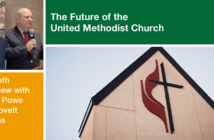Lovett H. Weems, Jr., says the current governance structure does not fit the realities of a global United Methodist Church. He suggests that General Conference focus on theological and historical identity, mission, and values, while Annual Conferences focus on context-sensitive structure and regulations, including clergy standards.
As if more evidence were needed to show the desperate plight of the church, the damage delivered to the U.S. church by the recent Special General Conference let the whole nation know that something is amiss in a denomination historically known as a positive contributor to our national life. Make no mistake, the issue is not that there are diverse philosophies held within the United Methodist tent. No one doubts that. Most United Methodist leaders deal with such differences with both grace and integrity daily. The problem is we have a governance structure that does not fit the realities of a global church. It is time to rethink General Conference into a more appropriate yet essential role. It is time to move from structures of control to a culture of trust and grace. The General Conference could become the primary arena for defining two critical dimensions:
Theological and Historical Identity
A strong theological and historical identity can withstand a host of organizational mistakes, but even the most careful management cannot overcome a lack of shared identity. The early forerunners of United Methodists were few in number and resources; yet they had such a strong internal identity and culture that miraculous things happened. To endure, any movement needs a powerful and commonly shared integrating identity.
As time goes by, and especially when difficulties arise, an organization with a loss of shared identity turns blame inside, aimed at a host of perceived foes. Much more narrow identities replace the shared identity as rallying points for various constituencies. Since none of the smaller identities has the movement’s shared commitments at its core, there is no unifying center. Thus, the power of the “invisible leader” of common identity and purpose goes missing.
Rather than inhibiting diversity, a shared core identity makes greater diversity possible. Without a unifying center, inclusion becomes only a gathering of unrelated differences. Shared identity permits a loosening of the tight reins of central control to permit the flowering of diverse expressions of that identity. All the theological streams inspired and fed by the Wesleyan spirit continue to make important contributions to a more faithful Christian witness today and need inclusion in United Methodism’s theological identity. The goal is not to outdo those with whom we disagree. The goal is to turn with them toward the larger needs of a hurting world.
Mission and Values
Mission is what we exist to do. Mission must be the guiding star for all that happens in every corner of the worldwide church. The mission will be expressed distinctively among various contexts, but all will see themselves accomplishing the same purpose that God has called United Methodists to do. The apparent lack of alignment of mission and direction may be behind much of the church’s dilemma. Entities do not see their roles through the lens of the mission but rather view the mission through the lens of their priorities.
Values are commitments honored in fulfilling the mission. Values do not compete with mission, but rather shape how the mission is fulfilled. After an organization has been around for a long time, and particularly when in decline, values tend to supplant mission in importance. The problem with making values the priority is that one can fulfill values perfectly while failing to accomplish the mission.
Both mission and values are non-negotiable, but their sequence is crucial. Mission comes first, and values represent those commitments within which we fulfill the mission. The United Methodist Church is blessed with a richness of values — biblical, evangelical, ecumenical, inclusive, diverse, committed to justice, spirituality, peace, and education, to name but a few. Losing sight of such values leads to weakness just as viewing values apart from mission leads to weakness.
Who Decides Everything Else?
Context matters. Actions must be context-appropriate. Different contexts require a degree of flexibility and nimbleness to manifest the identity, mission, and values in ways appropriate for their situations. There is inevitable tension between adapting to one’s context and becoming captive to it. But the fear of cultural captivity is not an excuse to avoid a changing culture. No living things continue to thrive generation by generation without environmental adaptability.
What if the General Conference addressed matters of doctrine, mission, and values and gave freedom (such as Central Conferences already have today) in structure and regulations, including clergy standards? Thus, General Conference becomes a time for celebration, worship, and engagement with those elements of United Methodist identity that unite across all boundaries and differences. Other conferences would establish those policies and procedures they need to carry out their context-appropriate ministry. We live in a time when people are not anxious to have others make decisions for them or to speak for them. In the more diverse and global church of today, achieving a majority vote for a change or statement means little and may not adequately reflect what may be a wide disconnection from countless other communities and contexts.
The Annual Conference as the Basic Body of the Church
The Annual Conference is described in the Discipline as the “basic body” of the church. There is a reason that annual conferences are formed along geographic bounds and that jurisdictional and central conferences are forbidden to be based on anything other than geography. Even with mergers that have increased the geographic size of conferences, the annual conference continues to be the arena in which the culture and ethos of a region is best known and appreciated. It is appreciated not in the sense of thinking that everything is good, but rather in understanding how it came to be and how to relate to it in caring and logical ways. This does not mean that the territory encompassed by an annual conference, even the smallest, is monolithic. The opposite is usually the case. But it is within the annual conference that the subtleties and variations are best understood.
I have been struck over the years by how intimately acquainted conference leaders tend to be with the various cultures and people in their midst. They show a remarkable ability to operate with both integrity and understanding among the differences within their conferences. I have noticed that even those leaders who appear to be so unyielding in General Conference debates often function very differently within their annual conferences. I have been extraordinarily impressed with many who engage and account for the differences in their annual conferences with grace and understanding. It is as if the more tight-knit annual conference brings out the best in them even as the more distant General Conference brings out a very different approach.
This awareness means that the annual conference is the level at which propagation of the Wesleyan witness through the United Methodist Church is best guided. In the global context in which the church lives, that role is critical.
The General Conference is broken and appears unable to fix itself, at least in the short term. But we have an alternative in our heritage not based on the corporate centralization of the 20th century. It is the annual conference as the basic unit of the church. If we have seemingly irreconcilable differences, then let the annual conferences set their paths until God’s wisdom for the future is more clearly revealed. It’s time to devolve most decisions beyond doctrine, mission, and values to the annual conferences.
Related Resources
- Hope Rages by Lovett H. Weems, Jr.
- United Methodism’s Unfinished Business by Lovett H. Weems, Jr.
- Methodism as an Experiment in Grace by David McAllister-Wilson




